人教版九年级全册Unit 5 What are the shirts made of? 知识点总结(含短语 句型 精讲 作文)
文档属性
| 名称 | 人教版九年级全册Unit 5 What are the shirts made of? 知识点总结(含短语 句型 精讲 作文) | 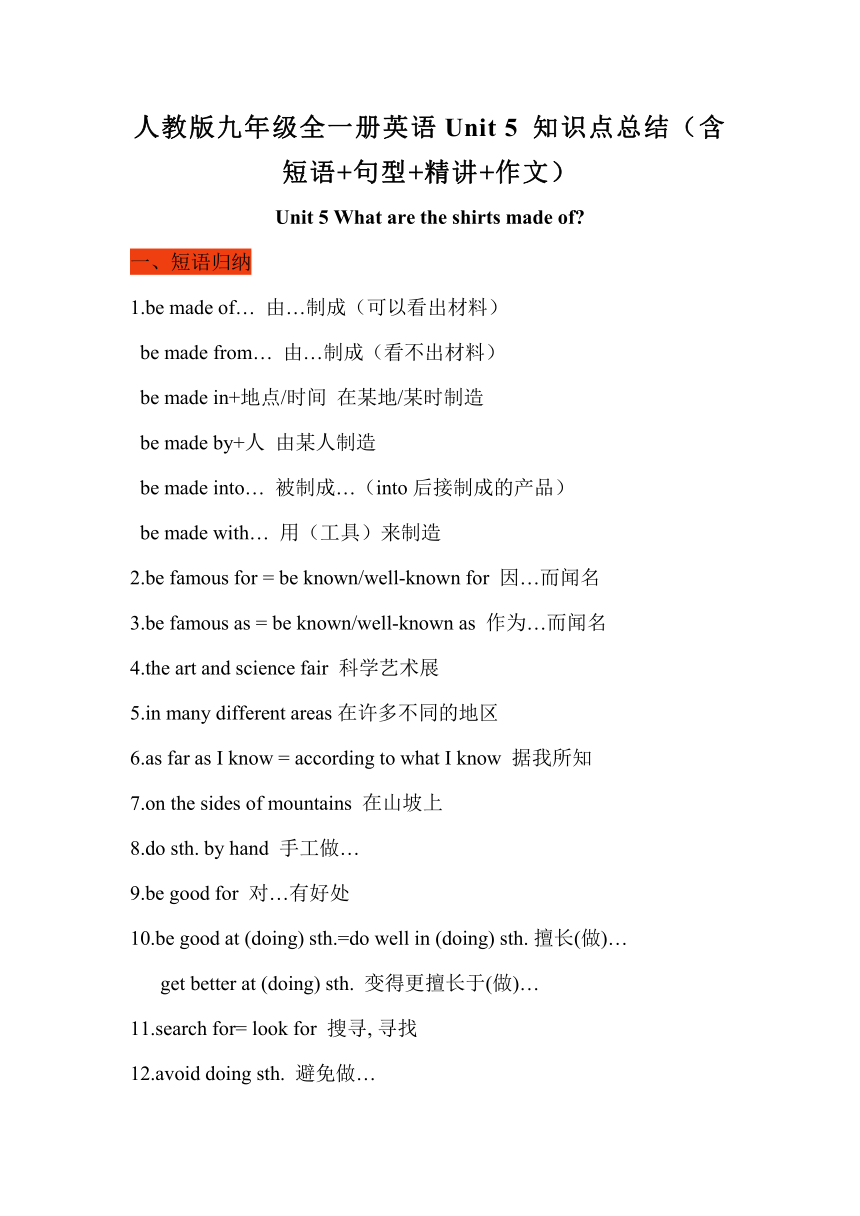 | |
| 格式 | docx | ||
| 文件大小 | 50.7KB | ||
| 资源类型 | 教案 | ||
| 版本资源 | 人教新目标(Go for it)版 | ||
| 科目 | 英语 | ||
| 更新时间 | 2024-10-05 21:54:01 | ||
图片预览

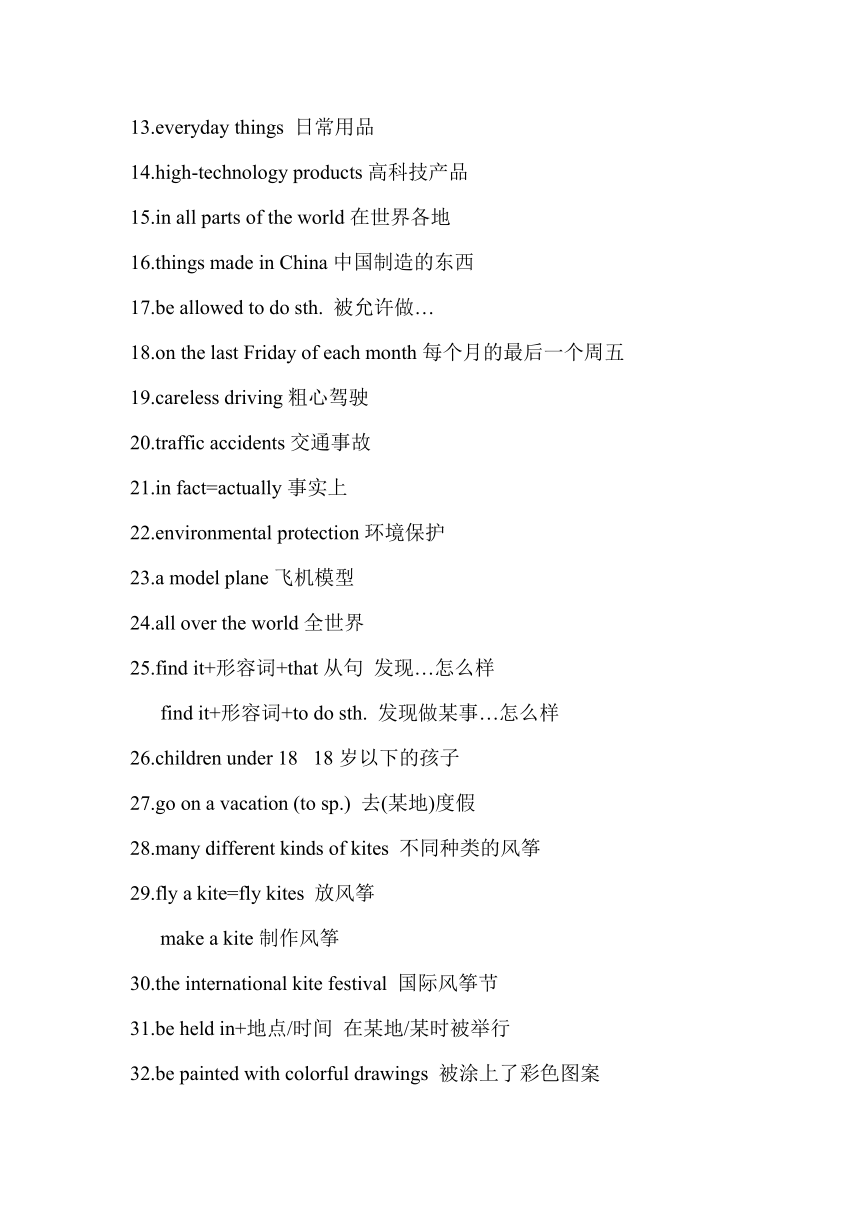
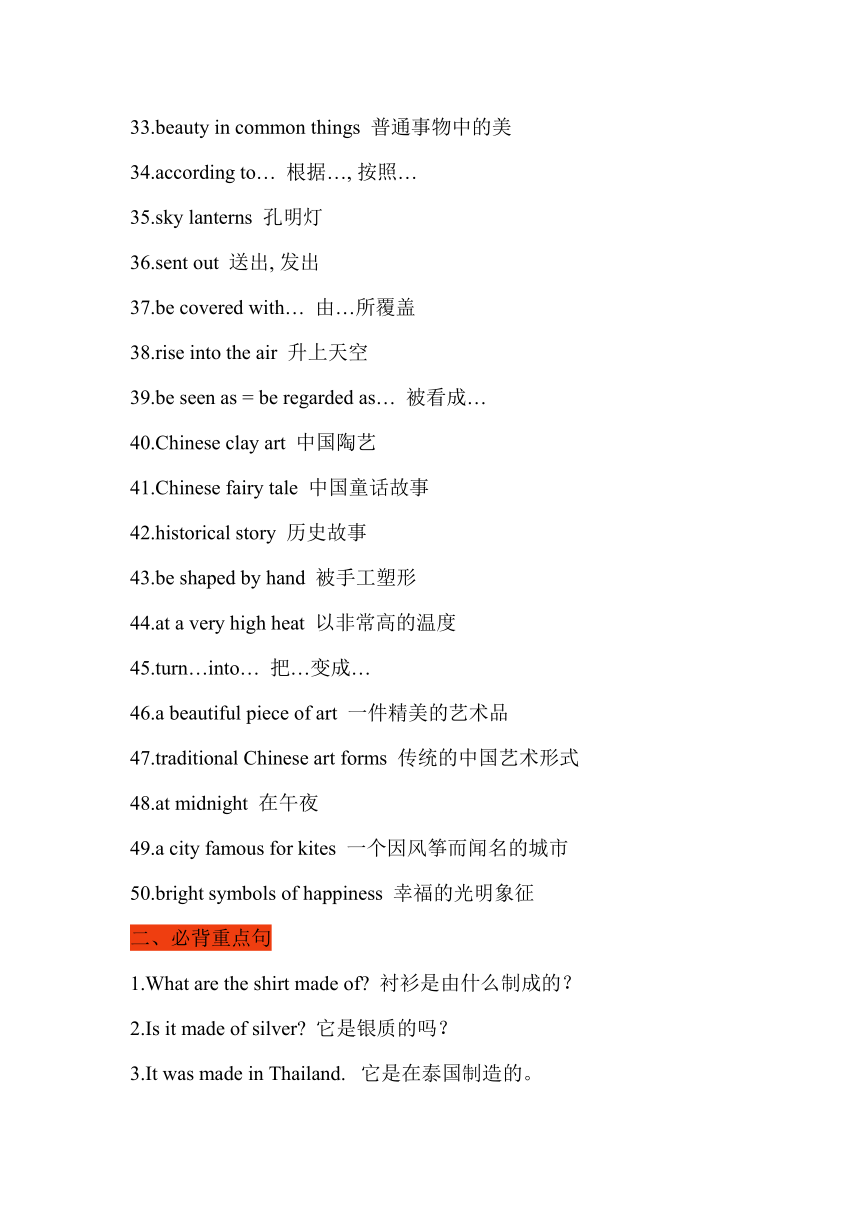
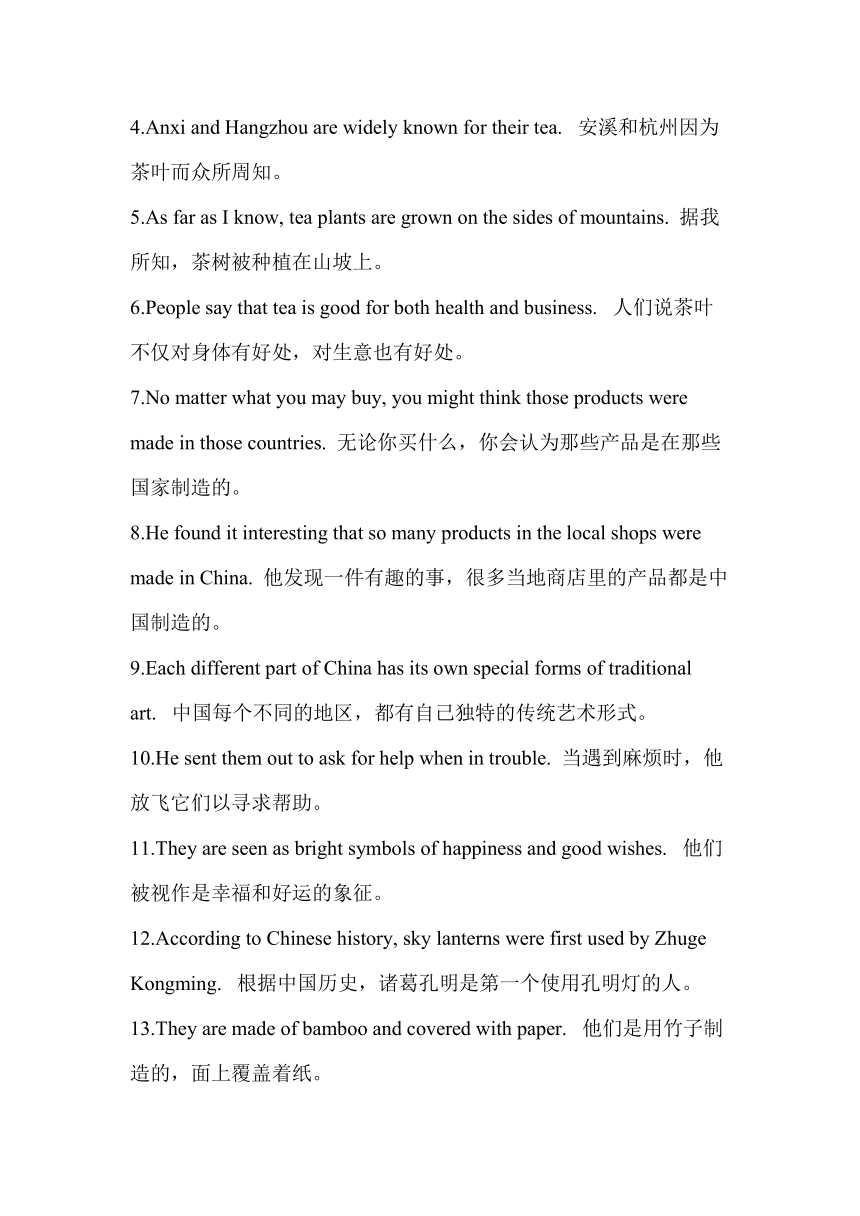
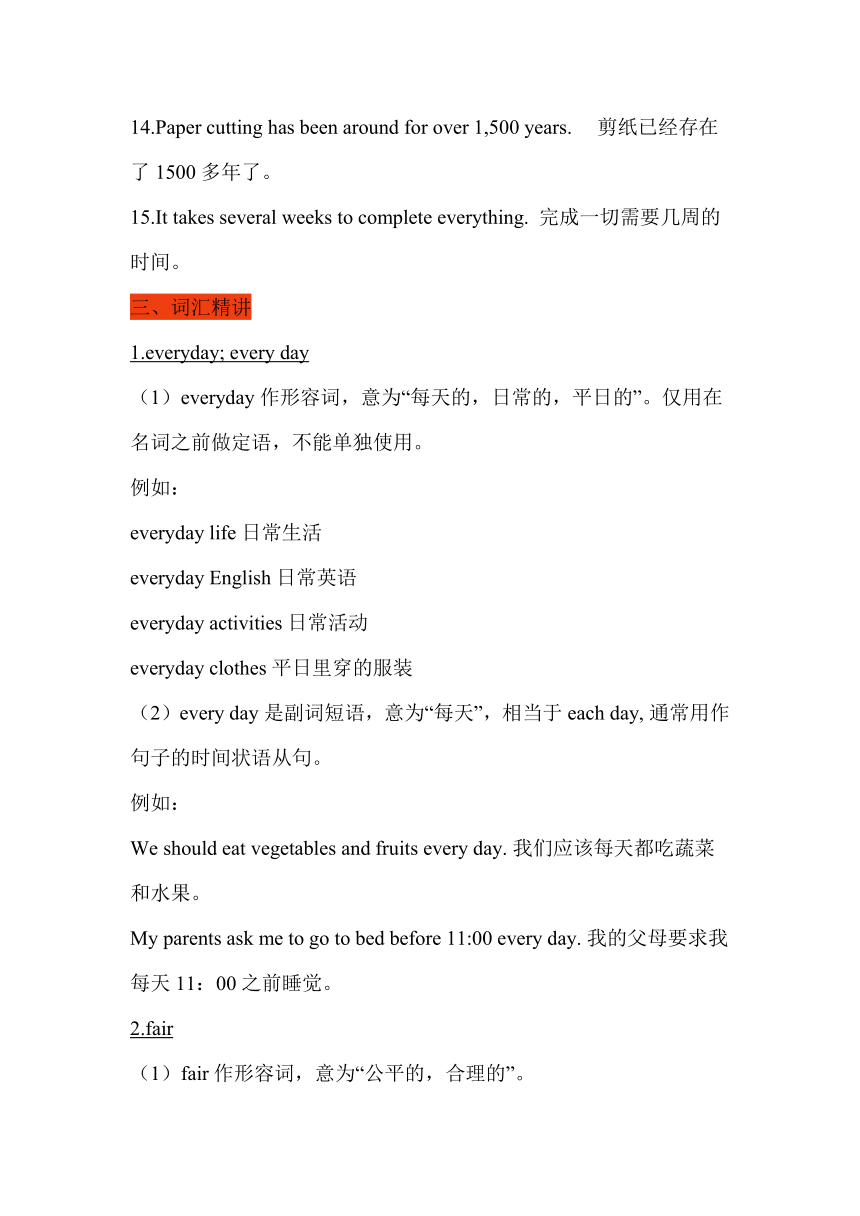
文档简介
人教版九年级全一册英语Unit 5 知识点总结(含短语+句型+精讲+作文)
Unit 5 What are the shirts made of
一、短语归纳
1.be made of… 由…制成(可以看出材料)
be made from… 由…制成(看不出材料)
be made in+地点/时间 在某地/某时制造
be made by+人 由某人制造
be made into… 被制成…(into后接制成的产品)
be made with… 用(工具)来制造
2.be famous for = be known/well-known for 因…而闻名
3.be famous as = be known/well-known as 作为…而闻名
4.the art and science fair 科学艺术展
5.in many different areas在许多不同的地区
6.as far as I know = according to what I know 据我所知
7.on the sides of mountains 在山坡上
8.do sth. by hand 手工做…
9.be good for 对…有好处
10.be good at (doing) sth.=do well in (doing) sth. 擅长(做)…
get better at (doing) sth. 变得更擅长于(做)…
11.search for= look for 搜寻, 寻找
12.avoid doing sth. 避免做…
13.everyday things 日常用品
14.high-technology products 高科技产品
15.in all parts of the world 在世界各地
16.things made in China 中国制造的东西
17.be allowed to do sth. 被允许做…
18.on the last Friday of each month 每个月的最后一个周五
19.careless driving 粗心驾驶
20.traffic accidents 交通事故
21.in fact=actually事实上
22.environmental protection 环境保护
23.a model plane飞机模型
24.all over the world全世界
25.find it+形容词+that从句 发现…怎么样
find it+形容词+to do sth. 发现做某事…怎么样
26.children under 18 18岁以下的孩子
27.go on a vacation (to sp.) 去(某地)度假
28.many different kinds of kites 不同种类的风筝
29.fly a kite=fly kites 放风筝
make a kite 制作风筝
30.the international kite festival 国际风筝节
31.be held in+地点/时间 在某地/某时被举行
32.be painted with colorful drawings 被涂上了彩色图案
33.beauty in common things 普通事物中的美
34.according to… 根据…, 按照…
35.sky lanterns 孔明灯
36.sent out 送出, 发出
37.be covered with… 由…所覆盖
38.rise into the air 升上天空
39.be seen as = be regarded as… 被看成…
40.Chinese clay art 中国陶艺
41.Chinese fairy tale 中国童话故事
42.historical story 历史故事
43.be shaped by hand 被手工塑形
44.at a very high heat 以非常高的温度
45.turn…into… 把…变成…
46.a beautiful piece of art 一件精美的艺术品
47.traditional Chinese art forms 传统的中国艺术形式
48.at midnight 在午夜
49.a city famous for kites 一个因风筝而闻名的城市
50.bright symbols of happiness 幸福的光明象征
二、必背重点句
1.What are the shirt made of 衬衫是由什么制成的?
2.Is it made of silver 它是银质的吗?
3.It was made in Thailand. 它是在泰国制造的。
4.Anxi and Hangzhou are widely known for their tea. 安溪和杭州因为茶叶而众所周知。
5.As far as I know, tea plants are grown on the sides of mountains. 据我所知,茶树被种植在山坡上。
6.People say that tea is good for both health and business. 人们说茶叶不仅对身体有好处,对生意也有好处。
7.No matter what you may buy, you might think those products were made in those countries. 无论你买什么,你会认为那些产品是在那些国家制造的。
8.He found it interesting that so many products in the local shops were made in China. 他发现一件有趣的事,很多当地商店里的产品都是中国制造的。
9.Each different part of China has its own special forms of traditional art. 中国每个不同的地区,都有自己独特的传统艺术形式。
10.He sent them out to ask for help when in trouble. 当遇到麻烦时,他放飞它们以寻求帮助。
11.They are seen as bright symbols of happiness and good wishes. 他们被视作是幸福和好运的象征。
12.According to Chinese history, sky lanterns were first used by Zhuge Kongming. 根据中国历史,诸葛孔明是第一个使用孔明灯的人。
13.They are made of bamboo and covered with paper. 他们是用竹子制造的,面上覆盖着纸。
14.Paper cutting has been around for over 1,500 years. 剪纸已经存在了1500多年了。
15.It takes several weeks to complete everything. 完成一切需要几周的时间。
三、词汇精讲
1.everyday; every day
(1)everyday作形容词,意为“每天的,日常的,平日的”。仅用在名词之前做定语,不能单独使用。
例如:
everyday life 日常生活
everyday English 日常英语
everyday activities 日常活动
everyday clothes 平日里穿的服装
(2)every day 是副词短语,意为“每天”,相当于each day, 通常用作句子的时间状语从句。
例如:
We should eat vegetables and fruits every day. 我们应该每天都吃蔬菜和水果。
My parents ask me to go to bed before 11:00 every day. 我的父母要求我每天11:00之前睡觉。
2.fair
(1)fair作形容词,意为“公平的,合理的”。
例如:
There must be fair play whatever the competition is. 不管是什么样的竞赛都必须公平合理。
(2)fair作形容词,意为“自然的,理所当然的”。
例如:
It’s fair enough to ask your close friends to help. 向你的好朋友求助,这是很自然的/理所当然的。
(3)fair作形容词,还意为“相当大(多、远)的”。
例如:
They’ve made a fair amount of money. 他们赚了相当大的一笔钱。
(4)fair作形容词,也意为“(肤色)浅的,(头发)金色的”。
例如:
Her daughter has big eyes and fair hair. 她的女儿长着大大的眼睛,金色的头发。
【拓展】fair作名词,意为“(定期)集市、庙会;商品展览会、博览会”。
例如:
He brought his piglets to the fair. 他把小猪带到集市去卖。
A book fair is to be held next month. 下个月将举行书展。
3. avoid
(1)从意思上看,可表示“避开”或“躲避”(keep oneself from)某人或某物;也可表示“防止”(prevent)某事的发生。
例如 :
Try to avoid accidents. 尽量防止发生事故。
I avoided him as much as possible. 我尽量避开他。
You should avoid such mistakes. 你应当避免这样的错误。
(2)从用法上看,其后可接名词或代词作宾语,也可接动名词作宾语,但是不能接不定式作宾语。
例如:
他避而不答我的问题。
正:He avoided answering my questions.
误:He avoided to answer my questions.
要想不受影响是不可能的。
正:It was impossible to avoid being affected.
误:It was impossible to avoid to be affected
4. be famous for
(1)be famous for表示人以某种知识技能,作品或特征而出名;表示某地以某种特产或特征出名;或表示某事以其内容、特征、价值等而被人所知。
例如:
He is famous for his skill in playing football. 他因球艺而出名。
The area is famous for its green tea. 这个地区以产绿茶而著称。
【拓展】be famous as 表示“以……而出名”的意思,或确切地说是“作为……而出名”的意思,主要是表示人以某种身份或职业而出名,或表示某地方作为什么产地或地方而出名,或表示某事物以某种形式而出名。
例如:
Mark Twin was famous as a children-story writer. 马克·吐温作为儿童故事作家而著称。
This book is famous as a reference book. 这本书作为参考书而出名。
5. produce; product; production
(1)produce 作动词,表示“生产,制造,出产”的意思。
例如:
Tea is produced in many different areas in China. 中国很多地方都出产茶叶。
produce作名词,主要指农产品,是一个不可数的集合名词。
例如:
the agricultural produce农产品
the native produce土特产品
We need some fresh produce. 我们需要一些新鲜的农产品。
(2)product 主要指工业产品,也可指农产品,是可数名词。
例如:
farm product农产品
Petrol is the most important product of many Middle-East countries. 石油是许多中东国家最重要的产品。
【注意】有时用于引申义。
例如:
He saw man as the product of society. 他把人看作是社会的产物。
(3)production 通常不表示具体的产品,它主要指生产这一动作或过程,制作,摄制(电影、戏剧等),是不可数名词。
例如:
The company is famous for the production of small cars. 这家公司以生产小型汽车闻名。
【注意】production 除表示“生产”外,还可指艺术作品,此时为可数名词。
例如:
The theme of his late productions was life and death. 他晚期作品的主题是生与死。
production 还可以表示产量,是不可数名词。
例如:
the production of wheat 小麦生产产量
The production has increased. 产量已增加。
6. be good for
be good for意为“对……有好处,对……有益处”,介词for后接名词或代词。其反义词为be bad for,意为“对……有害处”。
例如:
Junk food is not good for our health. 垃圾食品对我们的健康没有好处。
Smoking is bad for you. 吸烟对你有害。
【拓展】
(1) be good to“对……好”,其反义短语为be bad to“对……不好”。介词to之后一般接表示人的名词或代词。
例如:
She is very good to us. 她对我们很好。
The boss is bad to his workers. 那个老板对他的工人不好。
(2) be good at“在……方面擅长”,介词at后面常接名词、代词或动词-ing形式,同义短语为do well in。
例如:
She is good at English and Chinese. = She does well in English and Chinese. 她擅长英语和汉语。
(3)be good with“和……相处得好;擅于和……相处”。
例如:
Are you good with children 你和孩子们相处得好吗?
7.turn … into ….
(1) turn … into…表示“把……变成…… ; 使……变成……”。
例如:
Can you turn this piece of paper into a flower 你能够把这张纸变成一朵花吗?
Please tell me how to turn the water into ice. 请告诉我怎么把水变成冰。
【拓展】turn into表示“转变;变成;成为”。
例如:
We think he’ll turn into a top-class player. 我们认为他会成为一流的选手。
I think I have got to stop or I might turn into a machine. 我想我得停下来了,否则我就会变成一台机器。
8.special
(1)special作形容词,意为“特殊的,特别的,专门的(反义词:ordinary)”,强调事物特有的性质、性格或专门的目的、用途。
例如:
You must have special permission to enter this room. 你必须得到特许才能进这个房间。
(2)especial 作形容词,意为“特别的,主要的,突出的(反义词:common)”,强调的是重要性,有“尤其、特别”之意。
例如:
He solved the problem of especial importance. 他解决了非常重要的问题。
9. both … and …
(1)both...and...意为“……和……都……”; “不仅……而且……”,连接两个并列的词或短语,不能用来连接句子。作主语时,谓语动词用复数形式,不受“就近原则”的限制。
例如:
Both Li Ming and Wei Hua are good at English.
【拓展】both...and...相对应的连词结构式neither…nor…表示“既不……也不……”。作主语时,谓语动词受“就近原则”的限制。
例如:
Neither you nor I am a student. 你和我都不是学生。
四、句式精讲
1.What are the shirts made of
(1)be made of /from意为“由……制成”。前者成品可以看出原材料,后者是成品看不出原材料的。
例如:
The chair is made of wood. 椅子是由木头制成的。(能看出原材料)
Paper is made from wood.纸是由木头制成的。(看不出原材料)
(2)be made up of… 相当于consist of…(由……组成)。
例如:
Our country is made up of 56 nations. 我们的国家是由56个民族组成的。
(3)be made in 意为“在……(地点)制造”
(4)be made by意为“由某人制作”或“用什么方式制成”
例如:
My mother likes to buy things which are made in China.我妈妈喜欢买中国产的东西。
This postcard was made by my sister.这张卡片是我妹妹做的.
2.It seems that many people all over the world drink Chinese tea.
(1)seem为连系动词,意为“好像,似乎”,后面可跟动词不定式或形容词作表语。
例如:
He seems quite happy.他好像非常高兴。
His temperature seems to be all right.他的体温似乎完全正常。
(2)It seems/seemed that…句型中,it为形式主语,that 引导的从句是真正的主语,表示“看来,好像,似乎”。
例如:
It seems that they don’t like the idea.他们似乎不喜欢这个主意。
It seemed that she was lying.看来她在撒谎。
3.Laura is trying to find out more about …
find out “(经研究或询问)了解到,找出”,后面常和有特殊疑问词(what/when/how/who等)引导的从句连用。
例如:
Can you find out what time the plane leaves 你能查清楚飞机几点钟起飞吗?
【拓展】find, look for与 find out
(1)find 意为“找到”,强调的是找的结果,通常指偶然发现。
例如:
Have you found the bike you lost last week 你找到上周丢的自行车了吗?
(2)look for意为“寻找”,强调的是找的动作或过程。
例如:
Are you still looking for that place 你还在寻找那个地方吗?
(3)find out指经过观察、调查,把某事、某物查出来、搞清楚、弄明白。
例如:
Can you find out what time the meeting starts 你能查清楚会议什么时候开始吗?
4.That sounds interesting.
sound在本句中做连系动词,后面接名词、形容词或从句构成系表结构,表示“听起来……”。
例如:
That sounds boring.那听起来很无聊。
Your idea sounds a good one.你的想法听起来很好。
【拓展】
类似的其他常用连系动词:taste 尝起来;touch 摸起来;smell 闻起来;look 看起来; feel 感觉起来。
例如:
This cake tastes delicious.这个蛋糕尝起来很好吃。
This kind of cloth feels soft.这种布料感觉很柔软。
5.No matter what you may buy, you might think those products were made in those countries.
(1)no matter作“无论”、“不管”解,用以引导表示让步的状语从句,常用在下列句型中:句型中的No matter what (who/when etc.)...分别表示“无论何事”、“无论何人”、“无论何时”等,这个从句可以置主句之前,也可以置主句之后。
例如:
No matter what you do, you must be very careful.不管做什么事,你都必须非常细心。
No matter who you are (=Whoever you are), I’ll never let you in.无论你是谁,我绝不让你进去。
No matter which… 无论哪一个……
例如:
No matter which you choose (= Whichever you choose), you will be satisfied.不论你选择哪一个,你都会满意的。
No matter where… 无论何处;不管在哪里……
例如:
No matter where I go (= Wherever I go), I will be thinking of you.无论我到哪里,我都会想着你。
No matter when … 无论何时,不管什么时候……
例如:
I’ll discuss it with you no matter when you like (=whenever you like).你什么时候高兴,我愿意同你讨论这件事。
No matter how… 不管……如何;无论……多么……
例如:
No matter how hard you try (=However hard you try), you will never be successful.不管你如何努力,你都不会成功的。
五、语法精讲
passive voice in present tense 现在时的被动语态
1. 语态的定义及分类:
英语动词有两种语态:
主动语态(Active Voice):当主语为动作的执行者时,谓语用主动语态。
被动语态(Passive Voice):当主语为动作的承受者时,谓语用被动语态。
例如:
Many people speak English.(主动语态,句子的主语many people是动作speak的执行者)
English is spoken by many people. (被动语态,句子的主语English是动作speak的承受者)
2. 被动语态的构成:
被动语态是由“助动词be + 过去分词”构成,be在这里为助动词,必须与主语的人称和数保持一致,并有时态变化。被动语态的谓语动词的执行者可由by引出,往往放在句末,如不强调动作的执行者时,可省略不用。
例如:
The telephone was invented by Bell in 1876. 电话是贝尔在1876年发明的。
The model plane is made of wood and glass.这个飞机模型是由木头和玻璃制的。
Tea plants are grown on the sides of mountains.茶树种植在上边上。
3.主动语态变被动语态
(1)将主动语态的宾语变为主语。
(2)将主动语态的谓语变成被动式,即:be + 过去分词,并通过be的变化来体现不同的时态。
(3)将主动语态的主语变为被动语态中的by的宾语(有时候by短语可以省略),如果主语态中有两个宾语(直接宾语和间接宾语),可以把其中任何一个比那次被动语态的主语。
【主变被解题步骤】
1) 划分句子成分,找宾语 ----即动作的承受者
2) 判断宾语的单复数 ----即be动词的单复数
3) 判断动词的时态 ----即be动词的时态
4) 修改谓语的形式 ----即原句动词改为过去分词
5) 修改原句的主语 ----即by+ 宾语(原主语)
4.一般现在时态被动语态
一般现在时态的被动语态的肯定式、否定式及疑问式如下(以ask为例):
【知识点拓展】
①不知道谁是动作的执行者时。
如:Some new computers were stolen last night.一些新电脑在昨晚被盗了。(不知道是谁偷的)
②没有必要指出谁是动作的执行者时。
如:Books mustn’t be taken out of the library.书不准被带出图书馆。
③强调或突出动作的承受者,而不强调动作的执行者时。
如:The boy was beaten by his father because of his bad grade.因为成绩不好,这个男孩被他爸爸打了。
④当动作的执行者指“物”时,多用被动语态。
如:The window was broken by wind.窗户被风刮坏了。
⑤表示客观的说明,常用“It is+过去分词+that从句”句型。
如:It is said/believed/reported/known that...据说/大家相信/据报道/众所周知……
⑥文章的标题、广告、新闻等用语也常使用被动语态。
如: Teacher wanted.(招聘老师,省去了are) Road Blocked.(道路堵塞,省去了is)
六、作文积累
1.话题分析:本单元的话题围绕某种产品的材质、产地、用途及特殊性等信息而展开。
素材积累产品介绍类常用词汇:
chopstick, fork, blouse, gloves, glass, cotton, steel, handbag, material; produce, process, product, local, heat, be made of, by hand, turn into, cover…with, everyday, lively, be known for, soft, strong, interesting, smooth, real, small, cute, useful, helpful
产品介绍类常用句型:
My town/city/country is famous for…
…is becoming more and more popular.
It's more convenient for…
…is made of/from / by/ in…
…is / are known for…
…is/are used for…
…is / are special because…
2.典型例题
(1) 我们身边有着各种各样的小发明, 它们虽然看起来不起眼, 但在我们的日常生活中却有着很大作用。请你以“A Small Invention that I Love Most”为题, 结合下面的提示, 写一篇英语短文来介绍一件这样的小发明。
提示:
What's the invention
Who was it invented by
How was it invented
What's it used for
要求:必须包括提示要点, 可适当发挥 ;不少于80词, 适当运用一般过去时的被动语态。
A Small Invention that I Love Most
Although a lot of inventions are small, they're very useful for people's life. One of my favorite small inventions is the ballpoint pen, which is used for writing. The modern ballpoint pen was invented by Laszlo Biro. While he worked as a reporter in Hungary, he noticed that the ink used in newspaper printing dried quickly. He tried to use the same ink in a pen and developed a special pen tip. This new kind of pen was called a ballpoint pen. We can take it wherever we go, without taking ink bottles.The ballpoint pens are not only cheap but also convenient, so they are widely used by both students and adults around the world.
(2) 假如你有一个漂亮的蓝色的小手提包, 它产自江苏苏州。纯手工制成, 为苏州艺术品, 小手提包上的花和山脉栩栩如生, 你很喜欢它。据此写一篇80词左右的作文来介绍一下这个手提包。
参考词汇:be made of; be made by; by hand; be used forI have a handbag.
It's very beautiful. It's made in Suzhou, Jiangsu Province. It's made of cotton. Also, it's made by the workers in Suzhou and it's made completely by hand. It's blue. It's very special because it's a work of art. The flowers and mountains are so lively that you may think the picture on the handbag is real. It's used for holding my personal things when I go out. It's just like a friend of mine. I like it very much.
(3) 剪纸(paper cutting) 是中国最流行的传统的民间艺术形式之一。中国剪纸有一千五百多年的历史, 在明朝和清朝时期(the Ming and Qing Dynasties)特别流行。人们常用剪纸美化居家环境。特别是在春节和婚庆期间, 剪纸被用来装饰门窗和房间, 以增加喜庆的气氛。剪纸最常用的颜色是红色, 象征健康和兴旺。中国剪纸在世界各地都很受欢迎, 经常被用作馈赠外国友人的礼物。
要求:请根据以上信息写一篇80 词左右的文章。
提示词:folk art 民间艺术;wedding celebrations 婚庆;enhance 增强;atmosphere 气氛;symbolize 象征;prosperity 兴旺
Paper cutting is one of the most popular forms of traditional Chinese folk art. Chinese paper cutting has a history of more than 1,500 years. It was developed into an art form particularly during the Ming and Qing Dynasties. People often beautify their homes with paper cuttings. During the Spring Festival and wedding celebrations, paper cuttings are used to decorate doors, windows and rooms in order to enhance the pleasant atmosphere. The color most commonly used in paper cutting is red because it symbolizes health and prosperity. Chinese paper cuttings are very popular around the world and they are often given as presents to foreign friends.
Unit 5 What are the shirts made of
一、短语归纳
1.be made of… 由…制成(可以看出材料)
be made from… 由…制成(看不出材料)
be made in+地点/时间 在某地/某时制造
be made by+人 由某人制造
be made into… 被制成…(into后接制成的产品)
be made with… 用(工具)来制造
2.be famous for = be known/well-known for 因…而闻名
3.be famous as = be known/well-known as 作为…而闻名
4.the art and science fair 科学艺术展
5.in many different areas在许多不同的地区
6.as far as I know = according to what I know 据我所知
7.on the sides of mountains 在山坡上
8.do sth. by hand 手工做…
9.be good for 对…有好处
10.be good at (doing) sth.=do well in (doing) sth. 擅长(做)…
get better at (doing) sth. 变得更擅长于(做)…
11.search for= look for 搜寻, 寻找
12.avoid doing sth. 避免做…
13.everyday things 日常用品
14.high-technology products 高科技产品
15.in all parts of the world 在世界各地
16.things made in China 中国制造的东西
17.be allowed to do sth. 被允许做…
18.on the last Friday of each month 每个月的最后一个周五
19.careless driving 粗心驾驶
20.traffic accidents 交通事故
21.in fact=actually事实上
22.environmental protection 环境保护
23.a model plane飞机模型
24.all over the world全世界
25.find it+形容词+that从句 发现…怎么样
find it+形容词+to do sth. 发现做某事…怎么样
26.children under 18 18岁以下的孩子
27.go on a vacation (to sp.) 去(某地)度假
28.many different kinds of kites 不同种类的风筝
29.fly a kite=fly kites 放风筝
make a kite 制作风筝
30.the international kite festival 国际风筝节
31.be held in+地点/时间 在某地/某时被举行
32.be painted with colorful drawings 被涂上了彩色图案
33.beauty in common things 普通事物中的美
34.according to… 根据…, 按照…
35.sky lanterns 孔明灯
36.sent out 送出, 发出
37.be covered with… 由…所覆盖
38.rise into the air 升上天空
39.be seen as = be regarded as… 被看成…
40.Chinese clay art 中国陶艺
41.Chinese fairy tale 中国童话故事
42.historical story 历史故事
43.be shaped by hand 被手工塑形
44.at a very high heat 以非常高的温度
45.turn…into… 把…变成…
46.a beautiful piece of art 一件精美的艺术品
47.traditional Chinese art forms 传统的中国艺术形式
48.at midnight 在午夜
49.a city famous for kites 一个因风筝而闻名的城市
50.bright symbols of happiness 幸福的光明象征
二、必背重点句
1.What are the shirt made of 衬衫是由什么制成的?
2.Is it made of silver 它是银质的吗?
3.It was made in Thailand. 它是在泰国制造的。
4.Anxi and Hangzhou are widely known for their tea. 安溪和杭州因为茶叶而众所周知。
5.As far as I know, tea plants are grown on the sides of mountains. 据我所知,茶树被种植在山坡上。
6.People say that tea is good for both health and business. 人们说茶叶不仅对身体有好处,对生意也有好处。
7.No matter what you may buy, you might think those products were made in those countries. 无论你买什么,你会认为那些产品是在那些国家制造的。
8.He found it interesting that so many products in the local shops were made in China. 他发现一件有趣的事,很多当地商店里的产品都是中国制造的。
9.Each different part of China has its own special forms of traditional art. 中国每个不同的地区,都有自己独特的传统艺术形式。
10.He sent them out to ask for help when in trouble. 当遇到麻烦时,他放飞它们以寻求帮助。
11.They are seen as bright symbols of happiness and good wishes. 他们被视作是幸福和好运的象征。
12.According to Chinese history, sky lanterns were first used by Zhuge Kongming. 根据中国历史,诸葛孔明是第一个使用孔明灯的人。
13.They are made of bamboo and covered with paper. 他们是用竹子制造的,面上覆盖着纸。
14.Paper cutting has been around for over 1,500 years. 剪纸已经存在了1500多年了。
15.It takes several weeks to complete everything. 完成一切需要几周的时间。
三、词汇精讲
1.everyday; every day
(1)everyday作形容词,意为“每天的,日常的,平日的”。仅用在名词之前做定语,不能单独使用。
例如:
everyday life 日常生活
everyday English 日常英语
everyday activities 日常活动
everyday clothes 平日里穿的服装
(2)every day 是副词短语,意为“每天”,相当于each day, 通常用作句子的时间状语从句。
例如:
We should eat vegetables and fruits every day. 我们应该每天都吃蔬菜和水果。
My parents ask me to go to bed before 11:00 every day. 我的父母要求我每天11:00之前睡觉。
2.fair
(1)fair作形容词,意为“公平的,合理的”。
例如:
There must be fair play whatever the competition is. 不管是什么样的竞赛都必须公平合理。
(2)fair作形容词,意为“自然的,理所当然的”。
例如:
It’s fair enough to ask your close friends to help. 向你的好朋友求助,这是很自然的/理所当然的。
(3)fair作形容词,还意为“相当大(多、远)的”。
例如:
They’ve made a fair amount of money. 他们赚了相当大的一笔钱。
(4)fair作形容词,也意为“(肤色)浅的,(头发)金色的”。
例如:
Her daughter has big eyes and fair hair. 她的女儿长着大大的眼睛,金色的头发。
【拓展】fair作名词,意为“(定期)集市、庙会;商品展览会、博览会”。
例如:
He brought his piglets to the fair. 他把小猪带到集市去卖。
A book fair is to be held next month. 下个月将举行书展。
3. avoid
(1)从意思上看,可表示“避开”或“躲避”(keep oneself from)某人或某物;也可表示“防止”(prevent)某事的发生。
例如 :
Try to avoid accidents. 尽量防止发生事故。
I avoided him as much as possible. 我尽量避开他。
You should avoid such mistakes. 你应当避免这样的错误。
(2)从用法上看,其后可接名词或代词作宾语,也可接动名词作宾语,但是不能接不定式作宾语。
例如:
他避而不答我的问题。
正:He avoided answering my questions.
误:He avoided to answer my questions.
要想不受影响是不可能的。
正:It was impossible to avoid being affected.
误:It was impossible to avoid to be affected
4. be famous for
(1)be famous for表示人以某种知识技能,作品或特征而出名;表示某地以某种特产或特征出名;或表示某事以其内容、特征、价值等而被人所知。
例如:
He is famous for his skill in playing football. 他因球艺而出名。
The area is famous for its green tea. 这个地区以产绿茶而著称。
【拓展】be famous as 表示“以……而出名”的意思,或确切地说是“作为……而出名”的意思,主要是表示人以某种身份或职业而出名,或表示某地方作为什么产地或地方而出名,或表示某事物以某种形式而出名。
例如:
Mark Twin was famous as a children-story writer. 马克·吐温作为儿童故事作家而著称。
This book is famous as a reference book. 这本书作为参考书而出名。
5. produce; product; production
(1)produce 作动词,表示“生产,制造,出产”的意思。
例如:
Tea is produced in many different areas in China. 中国很多地方都出产茶叶。
produce作名词,主要指农产品,是一个不可数的集合名词。
例如:
the agricultural produce农产品
the native produce土特产品
We need some fresh produce. 我们需要一些新鲜的农产品。
(2)product 主要指工业产品,也可指农产品,是可数名词。
例如:
farm product农产品
Petrol is the most important product of many Middle-East countries. 石油是许多中东国家最重要的产品。
【注意】有时用于引申义。
例如:
He saw man as the product of society. 他把人看作是社会的产物。
(3)production 通常不表示具体的产品,它主要指生产这一动作或过程,制作,摄制(电影、戏剧等),是不可数名词。
例如:
The company is famous for the production of small cars. 这家公司以生产小型汽车闻名。
【注意】production 除表示“生产”外,还可指艺术作品,此时为可数名词。
例如:
The theme of his late productions was life and death. 他晚期作品的主题是生与死。
production 还可以表示产量,是不可数名词。
例如:
the production of wheat 小麦生产产量
The production has increased. 产量已增加。
6. be good for
be good for意为“对……有好处,对……有益处”,介词for后接名词或代词。其反义词为be bad for,意为“对……有害处”。
例如:
Junk food is not good for our health. 垃圾食品对我们的健康没有好处。
Smoking is bad for you. 吸烟对你有害。
【拓展】
(1) be good to“对……好”,其反义短语为be bad to“对……不好”。介词to之后一般接表示人的名词或代词。
例如:
She is very good to us. 她对我们很好。
The boss is bad to his workers. 那个老板对他的工人不好。
(2) be good at“在……方面擅长”,介词at后面常接名词、代词或动词-ing形式,同义短语为do well in。
例如:
She is good at English and Chinese. = She does well in English and Chinese. 她擅长英语和汉语。
(3)be good with“和……相处得好;擅于和……相处”。
例如:
Are you good with children 你和孩子们相处得好吗?
7.turn … into ….
(1) turn … into…表示“把……变成…… ; 使……变成……”。
例如:
Can you turn this piece of paper into a flower 你能够把这张纸变成一朵花吗?
Please tell me how to turn the water into ice. 请告诉我怎么把水变成冰。
【拓展】turn into表示“转变;变成;成为”。
例如:
We think he’ll turn into a top-class player. 我们认为他会成为一流的选手。
I think I have got to stop or I might turn into a machine. 我想我得停下来了,否则我就会变成一台机器。
8.special
(1)special作形容词,意为“特殊的,特别的,专门的(反义词:ordinary)”,强调事物特有的性质、性格或专门的目的、用途。
例如:
You must have special permission to enter this room. 你必须得到特许才能进这个房间。
(2)especial 作形容词,意为“特别的,主要的,突出的(反义词:common)”,强调的是重要性,有“尤其、特别”之意。
例如:
He solved the problem of especial importance. 他解决了非常重要的问题。
9. both … and …
(1)both...and...意为“……和……都……”; “不仅……而且……”,连接两个并列的词或短语,不能用来连接句子。作主语时,谓语动词用复数形式,不受“就近原则”的限制。
例如:
Both Li Ming and Wei Hua are good at English.
【拓展】both...and...相对应的连词结构式neither…nor…表示“既不……也不……”。作主语时,谓语动词受“就近原则”的限制。
例如:
Neither you nor I am a student. 你和我都不是学生。
四、句式精讲
1.What are the shirts made of
(1)be made of /from意为“由……制成”。前者成品可以看出原材料,后者是成品看不出原材料的。
例如:
The chair is made of wood. 椅子是由木头制成的。(能看出原材料)
Paper is made from wood.纸是由木头制成的。(看不出原材料)
(2)be made up of… 相当于consist of…(由……组成)。
例如:
Our country is made up of 56 nations. 我们的国家是由56个民族组成的。
(3)be made in 意为“在……(地点)制造”
(4)be made by意为“由某人制作”或“用什么方式制成”
例如:
My mother likes to buy things which are made in China.我妈妈喜欢买中国产的东西。
This postcard was made by my sister.这张卡片是我妹妹做的.
2.It seems that many people all over the world drink Chinese tea.
(1)seem为连系动词,意为“好像,似乎”,后面可跟动词不定式或形容词作表语。
例如:
He seems quite happy.他好像非常高兴。
His temperature seems to be all right.他的体温似乎完全正常。
(2)It seems/seemed that…句型中,it为形式主语,that 引导的从句是真正的主语,表示“看来,好像,似乎”。
例如:
It seems that they don’t like the idea.他们似乎不喜欢这个主意。
It seemed that she was lying.看来她在撒谎。
3.Laura is trying to find out more about …
find out “(经研究或询问)了解到,找出”,后面常和有特殊疑问词(what/when/how/who等)引导的从句连用。
例如:
Can you find out what time the plane leaves 你能查清楚飞机几点钟起飞吗?
【拓展】find, look for与 find out
(1)find 意为“找到”,强调的是找的结果,通常指偶然发现。
例如:
Have you found the bike you lost last week 你找到上周丢的自行车了吗?
(2)look for意为“寻找”,强调的是找的动作或过程。
例如:
Are you still looking for that place 你还在寻找那个地方吗?
(3)find out指经过观察、调查,把某事、某物查出来、搞清楚、弄明白。
例如:
Can you find out what time the meeting starts 你能查清楚会议什么时候开始吗?
4.That sounds interesting.
sound在本句中做连系动词,后面接名词、形容词或从句构成系表结构,表示“听起来……”。
例如:
That sounds boring.那听起来很无聊。
Your idea sounds a good one.你的想法听起来很好。
【拓展】
类似的其他常用连系动词:taste 尝起来;touch 摸起来;smell 闻起来;look 看起来; feel 感觉起来。
例如:
This cake tastes delicious.这个蛋糕尝起来很好吃。
This kind of cloth feels soft.这种布料感觉很柔软。
5.No matter what you may buy, you might think those products were made in those countries.
(1)no matter作“无论”、“不管”解,用以引导表示让步的状语从句,常用在下列句型中:句型中的No matter what (who/when etc.)...分别表示“无论何事”、“无论何人”、“无论何时”等,这个从句可以置主句之前,也可以置主句之后。
例如:
No matter what you do, you must be very careful.不管做什么事,你都必须非常细心。
No matter who you are (=Whoever you are), I’ll never let you in.无论你是谁,我绝不让你进去。
No matter which… 无论哪一个……
例如:
No matter which you choose (= Whichever you choose), you will be satisfied.不论你选择哪一个,你都会满意的。
No matter where… 无论何处;不管在哪里……
例如:
No matter where I go (= Wherever I go), I will be thinking of you.无论我到哪里,我都会想着你。
No matter when … 无论何时,不管什么时候……
例如:
I’ll discuss it with you no matter when you like (=whenever you like).你什么时候高兴,我愿意同你讨论这件事。
No matter how… 不管……如何;无论……多么……
例如:
No matter how hard you try (=However hard you try), you will never be successful.不管你如何努力,你都不会成功的。
五、语法精讲
passive voice in present tense 现在时的被动语态
1. 语态的定义及分类:
英语动词有两种语态:
主动语态(Active Voice):当主语为动作的执行者时,谓语用主动语态。
被动语态(Passive Voice):当主语为动作的承受者时,谓语用被动语态。
例如:
Many people speak English.(主动语态,句子的主语many people是动作speak的执行者)
English is spoken by many people. (被动语态,句子的主语English是动作speak的承受者)
2. 被动语态的构成:
被动语态是由“助动词be + 过去分词”构成,be在这里为助动词,必须与主语的人称和数保持一致,并有时态变化。被动语态的谓语动词的执行者可由by引出,往往放在句末,如不强调动作的执行者时,可省略不用。
例如:
The telephone was invented by Bell in 1876. 电话是贝尔在1876年发明的。
The model plane is made of wood and glass.这个飞机模型是由木头和玻璃制的。
Tea plants are grown on the sides of mountains.茶树种植在上边上。
3.主动语态变被动语态
(1)将主动语态的宾语变为主语。
(2)将主动语态的谓语变成被动式,即:be + 过去分词,并通过be的变化来体现不同的时态。
(3)将主动语态的主语变为被动语态中的by的宾语(有时候by短语可以省略),如果主语态中有两个宾语(直接宾语和间接宾语),可以把其中任何一个比那次被动语态的主语。
【主变被解题步骤】
1) 划分句子成分,找宾语 ----即动作的承受者
2) 判断宾语的单复数 ----即be动词的单复数
3) 判断动词的时态 ----即be动词的时态
4) 修改谓语的形式 ----即原句动词改为过去分词
5) 修改原句的主语 ----即by+ 宾语(原主语)
4.一般现在时态被动语态
一般现在时态的被动语态的肯定式、否定式及疑问式如下(以ask为例):
【知识点拓展】
①不知道谁是动作的执行者时。
如:Some new computers were stolen last night.一些新电脑在昨晚被盗了。(不知道是谁偷的)
②没有必要指出谁是动作的执行者时。
如:Books mustn’t be taken out of the library.书不准被带出图书馆。
③强调或突出动作的承受者,而不强调动作的执行者时。
如:The boy was beaten by his father because of his bad grade.因为成绩不好,这个男孩被他爸爸打了。
④当动作的执行者指“物”时,多用被动语态。
如:The window was broken by wind.窗户被风刮坏了。
⑤表示客观的说明,常用“It is+过去分词+that从句”句型。
如:It is said/believed/reported/known that...据说/大家相信/据报道/众所周知……
⑥文章的标题、广告、新闻等用语也常使用被动语态。
如: Teacher wanted.(招聘老师,省去了are) Road Blocked.(道路堵塞,省去了is)
六、作文积累
1.话题分析:本单元的话题围绕某种产品的材质、产地、用途及特殊性等信息而展开。
素材积累产品介绍类常用词汇:
chopstick, fork, blouse, gloves, glass, cotton, steel, handbag, material; produce, process, product, local, heat, be made of, by hand, turn into, cover…with, everyday, lively, be known for, soft, strong, interesting, smooth, real, small, cute, useful, helpful
产品介绍类常用句型:
My town/city/country is famous for…
…is becoming more and more popular.
It's more convenient for…
…is made of/from / by/ in…
…is / are known for…
…is/are used for…
…is / are special because…
2.典型例题
(1) 我们身边有着各种各样的小发明, 它们虽然看起来不起眼, 但在我们的日常生活中却有着很大作用。请你以“A Small Invention that I Love Most”为题, 结合下面的提示, 写一篇英语短文来介绍一件这样的小发明。
提示:
What's the invention
Who was it invented by
How was it invented
What's it used for
要求:必须包括提示要点, 可适当发挥 ;不少于80词, 适当运用一般过去时的被动语态。
A Small Invention that I Love Most
Although a lot of inventions are small, they're very useful for people's life. One of my favorite small inventions is the ballpoint pen, which is used for writing. The modern ballpoint pen was invented by Laszlo Biro. While he worked as a reporter in Hungary, he noticed that the ink used in newspaper printing dried quickly. He tried to use the same ink in a pen and developed a special pen tip. This new kind of pen was called a ballpoint pen. We can take it wherever we go, without taking ink bottles.The ballpoint pens are not only cheap but also convenient, so they are widely used by both students and adults around the world.
(2) 假如你有一个漂亮的蓝色的小手提包, 它产自江苏苏州。纯手工制成, 为苏州艺术品, 小手提包上的花和山脉栩栩如生, 你很喜欢它。据此写一篇80词左右的作文来介绍一下这个手提包。
参考词汇:be made of; be made by; by hand; be used forI have a handbag.
It's very beautiful. It's made in Suzhou, Jiangsu Province. It's made of cotton. Also, it's made by the workers in Suzhou and it's made completely by hand. It's blue. It's very special because it's a work of art. The flowers and mountains are so lively that you may think the picture on the handbag is real. It's used for holding my personal things when I go out. It's just like a friend of mine. I like it very much.
(3) 剪纸(paper cutting) 是中国最流行的传统的民间艺术形式之一。中国剪纸有一千五百多年的历史, 在明朝和清朝时期(the Ming and Qing Dynasties)特别流行。人们常用剪纸美化居家环境。特别是在春节和婚庆期间, 剪纸被用来装饰门窗和房间, 以增加喜庆的气氛。剪纸最常用的颜色是红色, 象征健康和兴旺。中国剪纸在世界各地都很受欢迎, 经常被用作馈赠外国友人的礼物。
要求:请根据以上信息写一篇80 词左右的文章。
提示词:folk art 民间艺术;wedding celebrations 婚庆;enhance 增强;atmosphere 气氛;symbolize 象征;prosperity 兴旺
Paper cutting is one of the most popular forms of traditional Chinese folk art. Chinese paper cutting has a history of more than 1,500 years. It was developed into an art form particularly during the Ming and Qing Dynasties. People often beautify their homes with paper cuttings. During the Spring Festival and wedding celebrations, paper cuttings are used to decorate doors, windows and rooms in order to enhance the pleasant atmosphere. The color most commonly used in paper cutting is red because it symbolizes health and prosperity. Chinese paper cuttings are very popular around the world and they are often given as presents to foreign friends.
同课章节目录
- Unit 1 How can we become good learners.
- Section A
- Section B
- Unit 2 I think that mooncakes are delicious!
- Section A
- Section B
- Unit 3 Could you please tell me where the restroom
- Section A
- Section B
- Unit 4 I used to be afraid of the dark.
- Section A
- Section B
- Unit 5 What are the shirts made of?
- Section A
- Section B
- Review of Units 1-5
- Unit 6 When was it invented?
- Section A
- Section B
- Unit 7 Teenagers should be allowed to choose their
- Section A
- Section B
- Unit 8 It must belong to Carla.
- Section A
- Section B
- Unit 9 I like music that I can dance to.
- Section A
- Section B
- Unit 10 You're supposed to shake hands.
- Section A
- Section B
- Review of Units 6-10
- Unit 11 Sad movies make me cry.
- Section A
- Section B
- Unit 12 Life is full of the unexpected
- Section A
- Section B
- Unit 13 We're trying to save the earth!
- Section A
- Section B
- Unit 14 I remember meeting all of you in Grade 7.
- Section A
- Section B
- Review of Units 11-14
